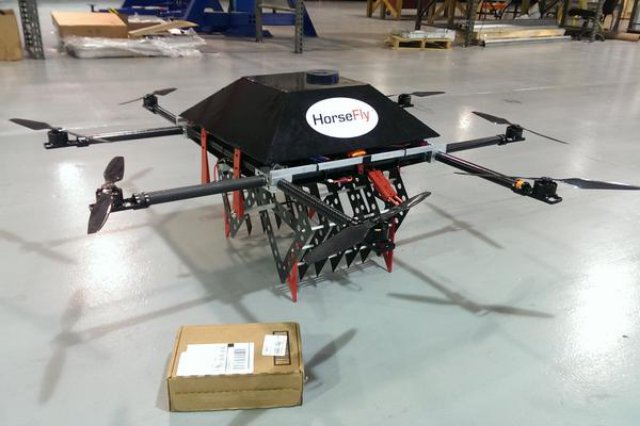is working with students in the University of Cincinnati Department of Aerospace Engineering on a drone that would be mounted on the top of its electric-powered trucks to finish the last leg of many deliveries.
“If I have a 10-pound package, should I drag this 20,000-pound truck up to Farmer Brown’s house and up his 2-mile driveway to deliver the package?” AMP CEO Steve Burns told me.”If you take a snapshot at 10 a.m. of any major city, delivery vans are everywhere. I dare say there’s nothing more than 3- to 5-miles away from a delivery truck at any given time.”
The HorseFly drones being developed would sit on top of AMP’s trucks with a claw reaching down into the vehicle’s bed. A driver puts a package into the claw, the drone scans the delivery information and take off toward the destination. Once the package is delivered, the drone seeks out the truck and returns to its perch.
A human pilot would operate the drone for the last 400 feet or so of the delivery to make sure the package gets where it needs to go, but the ultimate goal would be to have the drones eventually be completely autonomous.
Other companies have looked at the possibility of drone delivery – notably Amazon and Google – but what makes AMP different is that the drones would travel on top of a truck instead of being dispatched from a warehouse, Burns said.
A lot goes into creating a commercial drone. The UC/AMP team is crafting algorithms to keep the vehicle stable in different wind levels and change flight patterns due to the weight of a package.
The Federal Aviation Administration hasn’t yet finalized rules to govern the use of commercial drones, but Burns hopes the HorseFly will be ready once those come down. He said that could be as soon as next year.
“We’re trying to make it ready when the FAA sounds that gun,” he said. “It could be the next gold rush. There are a lot of pent-up applications waiting.”
Burns said the combination of drones and electric trucks could dramatically cut down on one of the largest costs of commercial shipping: diesel fuel.
Commercial trucks of the kind and size AMP produces generally get about 7 miles per gallon of fuel, Burns said.
It currently costs about $1 to move a 20,000-pound truck one mile, he said. With the electrification of the truck – and a small diesel generator to help recharge the battery and extend the range of the truck – AMP’s vehicles can get the equivalent of 21 or more miles per gallon. That reduces the cost of moving the truck 1 mile from $1 to less than 50 cents per mile. With drones handling the last leg of a delivery, that can bring the cost down to just a few cents per mile.
“Shipping is one of the last great bastions of holdout from modern technology. It really hasn’t changed in a long, long time,” Burns said. “If you look at the trucks we’re electrifying, they haven’t changed much in 100 years of modification.”
Source: Cincinnati Business Courier

